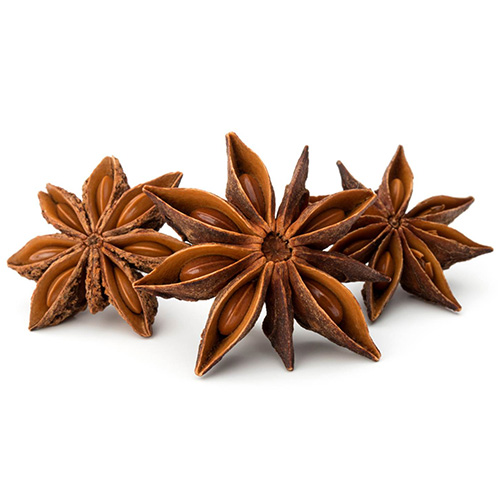STAR ANISE
Star anise is the dried, star shaped fruit of Illicium verum. It is an evergreen tree attaining a height of 8-15 meters and a diameter of 25 cm. The leaves are entire, 10-15 cm long, 2.5 – 5 cm broad, elliptic, flowers are solitary, white to red in colour. Fruits are star shaped, reddish brown consisting of 6-8 carpels arranged in a whorl. Each carpel is 10 mm long, boat shaped, hard and wrinkled containing a seed. Seeds are brown, compressed, ovoid, smooth, shiny and brittle. Star Anise is indigenous to South Eastern China. Commercial production is limited to China and Vietnam. In India, it is produced to a small extent in Arunachal Pradesh. The crop requires specific agro climatic conditions available only in the traditional growing areas, which has prevented repeated attempts of other countries to grow star anise. However it prefers woodlands, sunny edges, and dappled shade. The plant grows well in humus rich, mildly acidic to neutral soils, which are light to medium and having good drainage. It tolerates temperatures down to –10 degree C.
Botanical Name: Illicium verum
Family: Illiciaceae
Commercial Part: Dried Fruit
Uses
Star anise is one of the signature flavours of Chinese savory cooking. The five-spice powder mix common in China contains star anise. It is used to flavour vegetables, meat, and to marinate meat. It is used as a condiment for flavouring curries, confectionaries, spirits, and for pickling. It is also used in perfumery. The essential oil of star anise is used to flavour soft drinks, bakery products and liquors. The fruit is anti-bacterial, carminative, diuretic and stomachic. It is considered useful in flatulence and spasmodic.
Indian Name of Spices
Hindi : Anasphal, Malayalam : Takkolam, Marathi : Badian, Oriya : Anasphul, Tamil : Anashuppu, Telugu : Anaspuvu, Urdu : Badyani

